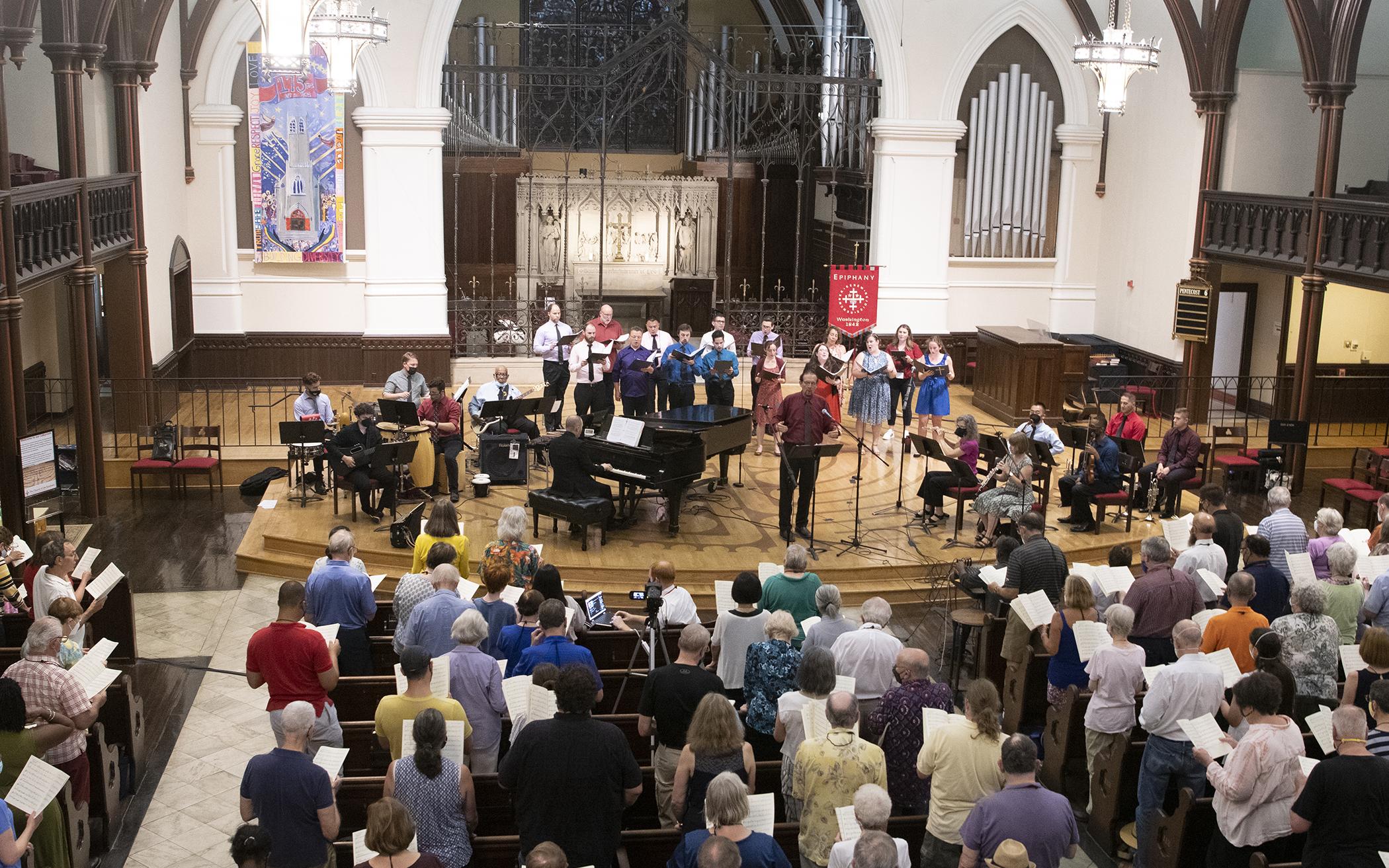The Banner has a subscription to republish articles from Religion News Service. This story by Adelle M. Banks was published on religionnews.com July 22, 2022. It has been edited for length.
With the theme “Sing the World God Imagines,” a gathering July 17-21 in Washington, D.C., celebrated 100 years of the Hymn Society of the U.S. and Canada, demonstrating the powerful influence hymns have, not only on faith communities but also on politics and society at large across the globe. Lecture sessions addressed topics such as the ongoing effects of colonialism on the texts and tunes they choose to sing.
Consciousness of hymns’ power has driven a growing diversity in the Christian hymnody, and members and guests meeting at the annual conference (the first able to assemble since 2019) insisted that the trend continue into the coming century.
“I have had the pleasure of watching this community grow to embrace and to celebrate the way the gospel can be preached and sung and prayed in many tongues and rhythms, calling forth an array of gifts much like the first-century church,” said conference preacher Cynthia A. Wilson, a United Methodist and leader of a new Black church music institute at Garrett-Evangelical Theological Seminary.
“But as we move into this century, friends, I promise we will not get through it without the boldness of protest, the power of prayer, and the potency of God’s song.”
Monday’s opening worship service featured Wilson’s sermon and songs like “Let it Rise,” “God Is Here,” and “Order my Steps.” For much of the rest of the meeting, participants, including several dozen online, took turns leading and learning unfamiliar songs from many lands as well as familiar hymns with new beats and new words.
The Hymn Society comprises representatives from more than 50 denominations who speak as many as six languages.
On Wednesday, Mikako Ehara, head of church music for the Japan Baptist Convention, taught “God’s World,” the song featuring a Japanese folk melody based on a nursery rhyme she compared to “The 12 Days of Christmas”—“where a line is added with each new verse” about creation as told in the Book of Genesis.
The Rev. Mikie Roberts, program executive for spiritual life and for faith and order for the World Council of Churches, described in a later plenary how his home country of Antigua and Barbuda had gained independence in 1981 in part through the use of patriotic hymns that reached people through their churches. To reach the most people, the tunes excluded the familiar syncopation of local Calypso music.
“The patriotic and the national songs had to be simple, yet direct, so that they could be promoted in schools, played on the air and sung every day including Sunday,” said Roberts, a Moravian pastor.
An international panel of speakers grappled with the origins of the hymnody in parts of the world where songs brought by Western missionaries are still revered more than other church music, including the songs of local cultures.
“We’re still in the process of decolonizing what we are singing,” said Gerardo Oberman, a leader of Reformed Churches in Argentina and one of the panelists, speaking through a translator. “We are still trying to find our own voice or trying to find our own rhythms. Because there’s a little bit of a disconnect between what we sing in our homes, what we sing on the streets, and what we sing in our churches.”
C. Michael Hawn, an Iowa native who has long advocated for including global music in American congregations’ worship services, said that, despite concerns about Western music’s dominance, some people across the globe made traditionally Western hymns genuinely their own.
Related: Celebration of Indigenous Ministry Sunday highlights worship music created by Indigenous peoples (CRC Network, May 5, 2022); Massachusetts Church Hosts Multilingual Worship Fest (March 27, 2020)
“I have developed a little bit more awareness and sympathy for ‘What a Friend We Have in Jesus’ being sung in Yoruba—or not just in the language, but in a style that reflects they’ve Africanized it,” said Hawn, professor emeritus of church music at Southern Methodist University’s Perkins School of Theology.
“And so it’s not a simple transplant; it’s a reconstruction, a certain kind of hybridity.”
Within three years of the Hymn Society’s first meeting in 1922, the Baptist Standard Hymnal and The Book of American Negro Spirituals were published. By the 1980s and 1990s, Hawn said, there was a greater consciousness of being inclusive, and hymnals began to include more global music. People developed more intentionality about “what sounds take place in a sacred space.”
The conference’s closing festival on Thursday, at National City Christian Church, mixed the church’s organ with the djembe, a West African drum, as well as voices and brass instruments and music by a range of composers.
“And now, as we prepare to go forth, may the spirit of God blow among us to bring forth new songs,” said McMahon as he closed the meeting, “songs of faith, songs of healing, songs of transformation, songs of peace, songs of a world remade.”
ⓒ Religion News Service 2022
About the Author
Religion News Service is an independent, nonprofit and award-winning source of global news on religion, spirituality, culture and ethics.

